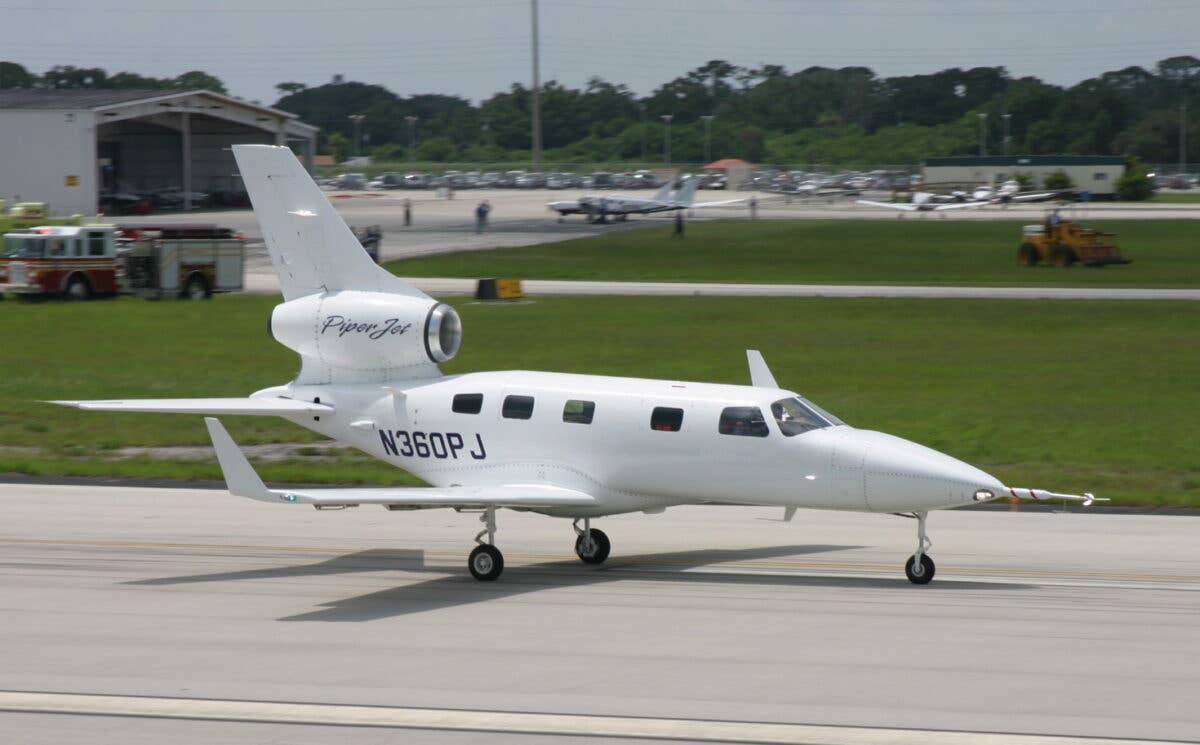The Rise and Stall of the Piper PA-47 PiperJet Program
The airframe configuration of the single-engine Piper PA-47 PiperJet presented a unique set of engineering challenges.

The PiperJet utilized a unique airframe configuration which created benefits and drawbacks. [Courtesy: Piper Aircraft]
When designing a single-engine jet, there are only so many places one can mount the engine. To avoid asymmetric thrust, it must be mounted on the centerline of the fuselage, and doing so introduces new challenges. Something must be done to provide the engine with clean, undisturbed air for the intake, for example, and the design must somehow prevent the hot exhaust from damaging tail surfaces.
In mid 2007, when many manufacturers were developing new designs for the newly-identified very light jet (VLJ) category, Piper began development of their own VLJ with the goal of finding the simplest solution possible. They decided against housing the engine within the fuselage, as this would present complex challenges with regard to ducting airflow cleanly through inlets. Additionally, an engine housed within the fuselage must be engineered to minimize the risk to the occupants in the event of an uncontained compressor blade or disk failure.
Avoiding such constraints necessitated an engine positioned outside of the fuselage, and to ease cabin access with shorter, lighter landing gear, this meant on top. Piper needed to protect the tail surfaces from the aforementioned hot engine exhaust, but they wanted to avoid the use of relatively heavy and complex designs like some competitors were using. The Eclipse 400 Concept Jet, for example, utilized a V-tail that required a separate engine pylon, and Adam Aircraft opted for a massive twin-boom design for their A700.
Perhaps drawing inspiration from the McDonnell Douglas DC-10 airliner, the team opted to integrate the engine with the vertical stabilizer. This configuration offered several significant advantages. Chief among them, the engine would be provided with clean, undisturbed airflow, and there would be no concerns about hot engine exhaust affecting the airframe.
The simplicity of this configuration provided some ancillary benefits, as well. Because the fuselage was relatively conventional, existing components could be used. For the proof-of-concept aircraft, the team repurposed a Meridian fuselage. The wing was also conventional and didn’t require any significant engineering beyond that of existing aircraft. Compared to an entirely clean-sheet design, these factors would reduce the complexities of certification and production.
This would also enable the team to focus on the unique engineering challenges introduced by the tail-mounted engine…and after the aircraft’s first flight took place in July of 2008, they discovered several to address. The most significant was identified early on in the design program - the high thrust line. Because the engine was placed so far above the aircraft’s center of gravity, the application of thrust would result in a nose-down pitching moment, and a thrust reduction would result in a nose-up pitching moment.
This thrust/pitch coupling could be addressed in several ways. Various systems like vectored thrust and active trim could be utilized, but systems like these introduce weight, complexity, and additional points of failure. Piper instead developed a simple and clever fixed nozzle system that produced a variable thrust angle.
The nozzle did so through the Coanda effect, in which air clings to a surface and can thus be aimed via this air pressure alone. At low speeds, the Coandă effect was pronounced and created a greater thrust vector that effectively countered the high thrust line. At high speeds, the effect was minimal and resulted in a 2.2 percent geometric loss of thrust, which was considered acceptable.
This system was a success. Even with the high thrust line, go arounds could be accomplished hands free, a rare handling characteristic even among more conventional designs. Test pilots reported power changes had a less pronounced effect than propeller-driven aircraft.
The team encountered another challenge when they discovered that the use of full flaps could produce a tail-plane stall. This would result in an uncommanded pitch down, which is obviously an undesirable characteristic. The issue was resolved by altering the horizontal stabilizer, increasing its span, increasing the elevator size, and adding 30 percent of sweep, which moved the aerodynamic center aft and solved the problem.
With significant engineering accomplishments under their belt and 180 pre-orders for the $2.2 million aircraft, Piper moved forward with development of a new version called the Altaire. The Altaire would incorporate a larger, roomier cabin, and projected performance of a 35,000-foot maximum cruise altitude, a 360-knot maximum cruise speed, and a 1,200- to 1,300-nm maximum range.
Despite the numerous engineering accomplishments and an optimistic initial outlook, the PiperJet program ultimately succumbed to market conditions. Economic and market forecasts became bleak, and rather than risk the company on a single new aircraft subject to the projected market downturn, Piper put the program on indefinite hold.
When it became clear the program would progress no further, the Smithsonian expressed an interest in acquiring the sole prototype, with the caveat that Piper include the first Piper/Taylor E-2 Cub ever sold. The Florida Air Museum in Lakeland also expressed an interest in acquiring the prototype but included no such contingencies and ultimately received the aircraft.
There, the sole PiperJet remains on display for the public and future generations to admire.

Sign-up for newsletters & special offers!
Get the latest FLYING stories & special offers delivered directly to your inbox






